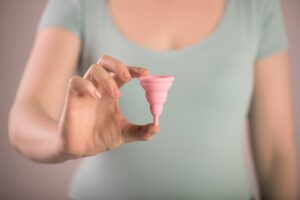Maintaining proper menstrual hygiene is crucial for preventing infections, managing discomfort, and ensuring overall health during your period. With a variety of menstrual products available, it’s essential to understand how to use them correctly and adopt hygiene practices that promote well-being.
Understanding Menstrual Products
- Sanitary Pads
Sanitary pads are absorbent materials worn inside underwear to collect menstrual flow. They come in various sizes and absorbencies to suit different needs.
Best Practices:- Change pads every 4-8 hours, or more frequently if needed, to prevent odor and bacterial growth.
- Choose pads made from breathable materials to reduce skin irritation.
- Dispose of used pads properly in a waste bin, never flush them down the toilet.
- Tampons
Tampons are inserted into the vagina to absorb menstrual flow internally. They are available in different sizes and absorbencies.
Best Practices:- Choose the lowest absorbency tampon that meets your needs to reduce the risk of Toxic Shock Syndrome (TSS).
- Change tampons every 4-8 hours, and never leave one in for longer than 8 hours.
- Wash your hands thoroughly before and after inserting or removing a tampon.
- Dispose of used tampons properly in a waste bin, never flush them down the toilet.
- Menstrual Cups
Menstrual cups are reusable, flexible cups inserted into the vagina to collect menstrual flow. They can be worn for up to 12 hours and are an eco-friendly alternative to pads and tampons.
Best Practices:- Choose a menstrual cup made from medical-grade silicone.
- Sterilize the cup before first use and between periods by boiling it in water for 5-10 minutes.
- Empty and rinse the cup with water every 8-12 hours.
- Wash your hands thoroughly before and after inserting or removing the cup.
- Menstrual Discs
Menstrual discs are similar to menstrual cups but sit higher in the vaginal canal, covering the cervix. They can be worn for up to 12 hours and are also reusable.
Best Practices:- Choose a menstrual disc made from medical-grade silicone.
- Sterilize the disc before first use and between periods by boiling it in water for 5-10 minutes.
- Empty and rinse the disc with water every 8-12 hours.
- Wash your hands thoroughly before and after inserting or removing the disc.
- Period Underwear
Period underwear is designed with absorbent layers to collect menstrual flow. They are reusable and can be worn alone or as a backup with other menstrual products.
Best Practices:- Choose period underwear made from breathable, moisture-wicking fabrics.
- Rinse the underwear with cold water after use to remove excess blood.
- Machine wash the underwear according to the manufacturer’s instructions.
Essential Menstrual Hygiene Practices
-
Regular Changing of Menstrual Products
Changing pads, tampons, or emptying menstrual cups regularly is crucial for preventing odor and bacterial growth. Follow the recommended usage times for each product. -
Proper Handwashing
Always wash your hands thoroughly with soap and water before and after changing menstrual products to prevent the spread of bacteria. -
Gentle Cleansing
Clean the external genital area gently with mild soap and water during your daily shower or bath. Avoid harsh soaps or douches, as they can disrupt the natural pH balance and increase the risk of infections. -
Avoid Scented Products
Scented pads, tampons, or wipes can irritate the sensitive skin in the vaginal area. Opt for unscented products to reduce the risk of allergic reactions or infections. -
Proper Disposal
Dispose of used pads and tampons properly in a waste bin. Never flush them down the toilet, as they can cause plumbing problems and environmental pollution. -
Keep Track of Your Cycle
Tracking your menstrual cycle can help you anticipate your period and be prepared with the necessary hygiene products. -
Choose Breathable Clothing
Wear loose-fitting, breathable cotton underwear to promote airflow and reduce moisture, which can help prevent yeast infections. -
Stay Hydrated
Drinking plenty of water can help reduce bloating and improve overall well-being during your period.
Addressing Common Concerns
-
Odor Control
Menstrual odor is normal, but changing menstrual products regularly and maintaining good hygiene can help minimize it. Avoid using scented products to mask odor, as they can cause irritation. -
Preventing Infections
Proper hygiene practices, such as regular changing of menstrual products and gentle cleansing, can help prevent bacterial and yeast infections. If you experience symptoms like itching, burning, or unusual discharge, consult a healthcare provider. -
Managing Discomfort
Wear comfortable clothing, use a heating pad for cramps, and take over-the-counter pain relievers as needed to manage discomfort during your period.
Conclusion
Maintaining proper menstrual hygiene is essential for a healthy and comfortable period. By understanding the best practices for using menstrual products and adopting good hygiene habits, you can prevent infections, manage discomfort, and promote overall well-being. If you have any concerns or questions about menstrual hygiene, consult a healthcare provider for personalized advice.
